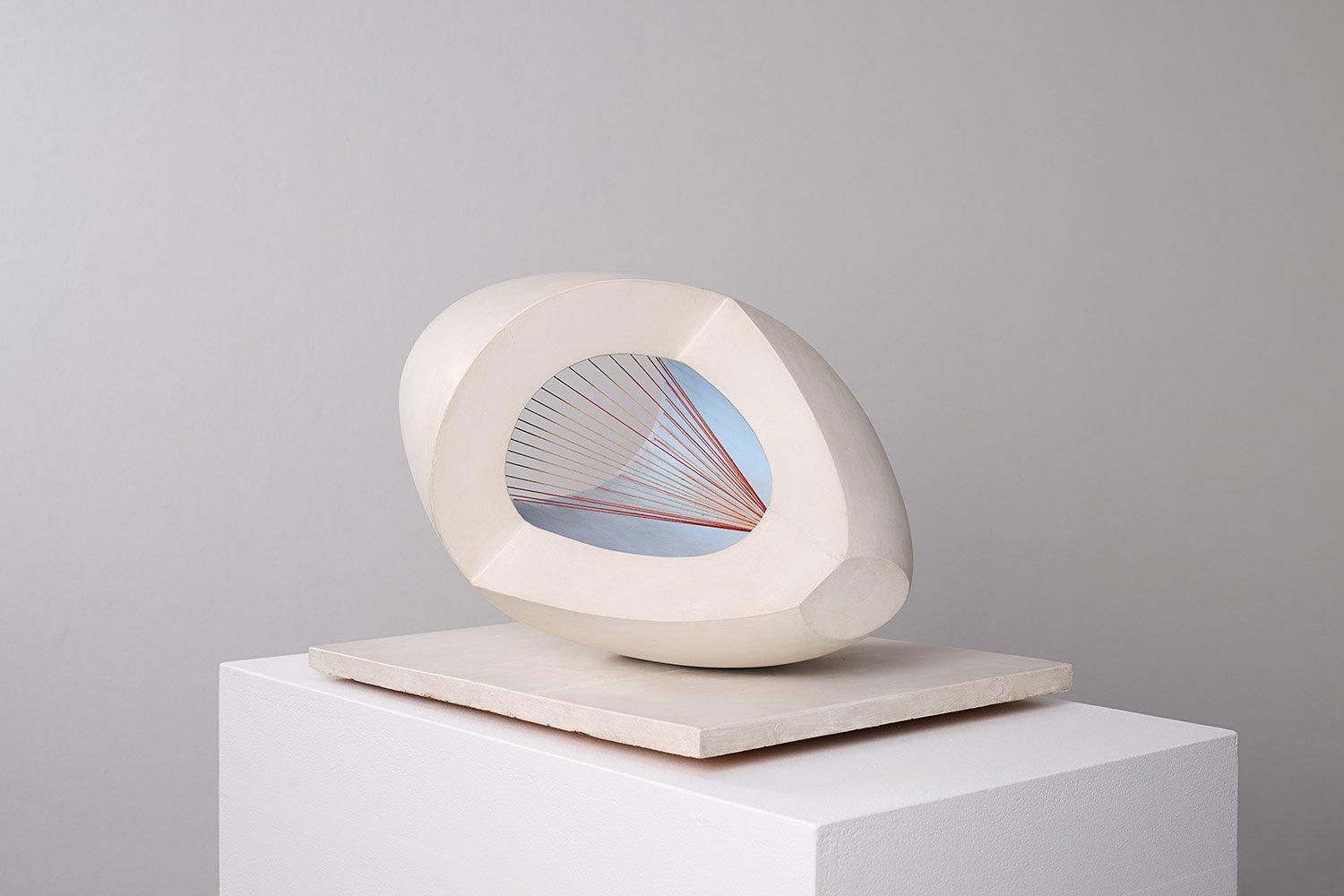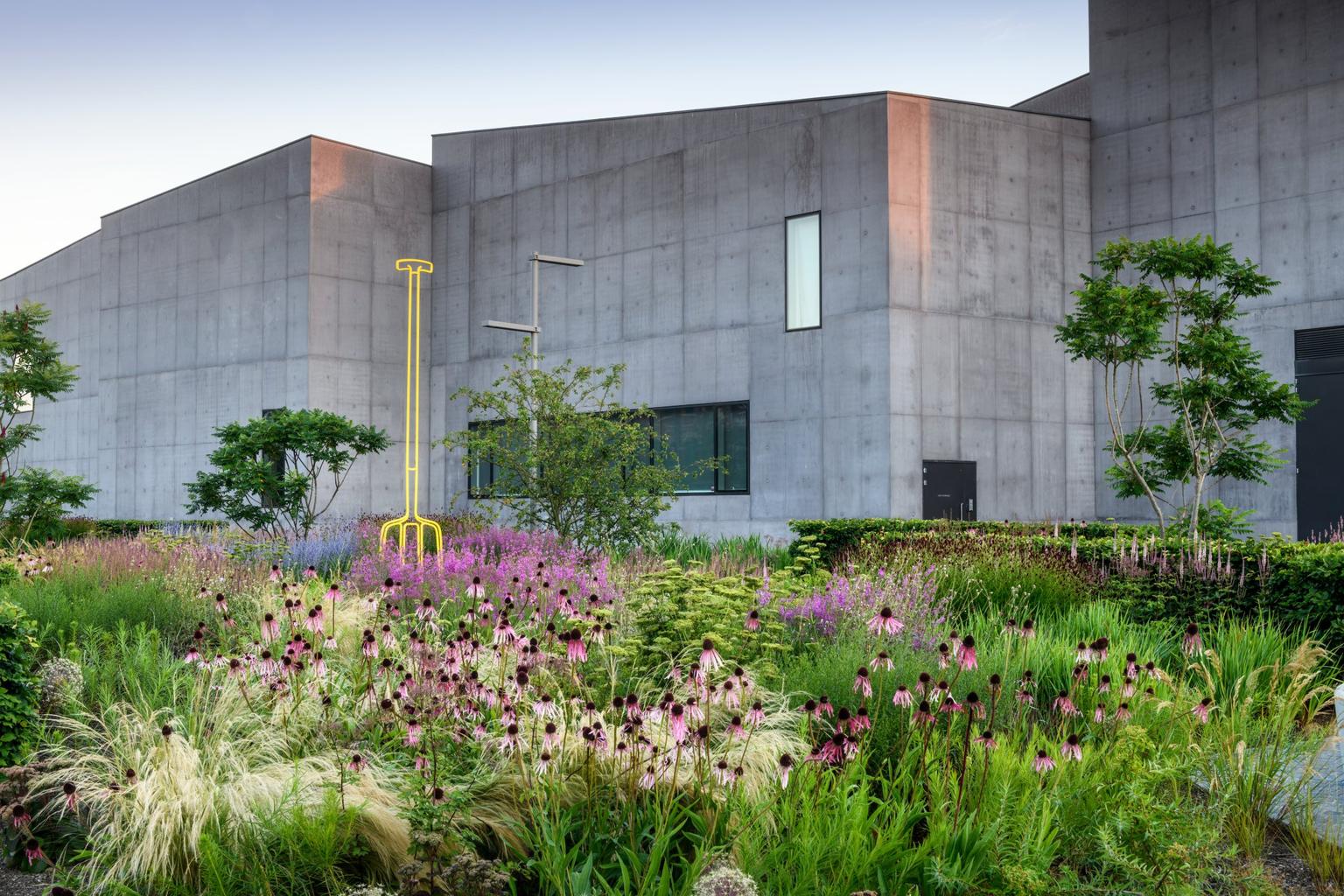Funds raised to save Hepworth's sculpture for future generations

Discover how crucial funds have been raised to help The Hepworth Wakefield acquire a sculpture by a titan of modern British art. And, learn about the importance of this remarkable work of art.
The Hepworth Wakefield and Art Fund are delighted to announce that their public appeal to raise the £3.8m needed to save Barbara Hepworth’s Sculpture with Colour (Oval Form) Pale Blue and Red for the UK has successfully reached its target, a week ahead of the deadline.
An outpouring of support and over 2,800 donations from members of the public means The Hepworth Wakefield are now able to acquire this outstanding sculpture by a titan of modern British art. Once acquired as part of the UK’s national collection, it can go on permanent public display at the award-winning gallery, in Hepworth’s hometown of Wakefield, for everyone to enjoy.
Too important to lose
Created under astonishing circumstances during the Second World War, Sculpture with Colour (Oval Form) Pale Blue and Red (1943) marks a breakthrough in Hepworth’s career; it is one of only a handful of wooden carvings made by Hepworth during the 1940s, and one of the first major wood carvings she made using strings.
In private ownership and rarely seen by the public, the sculpture was deemed a national treasure and too important to leave the UK. It was placed under a temporary export bar by the UK Government to prevent it from being lost overseas, and to give a UK museum the chance to acquire it for everyone to enjoy.
An unmissable opportunity for Wakefield
Now that the funds have been raised, the chance to acquire this sculpture will enhance The Hepworth Wakefield’s ability to tell the full story of Barbara Hepworth’s career and pioneering creativity in the city where she was born.
Their ambition is for local communities, schools, students and culture enthusiasts from across the UK and beyond to enjoy the sculpture in their galleries, for generations to come.
Stay tuned across our channels for details on when this remarkable sculpture goes on display.
The people who made this happen
Alongside 2,800 public donations the success of the appeal has been made possible with several major grants - including £1.89m from The National Lottery Heritage Fund, an exceptional grant of £750,000 from Art Fund, and further impactful support from the Deborah Loeb Brice Foundation, The Forster Foundation, Garcia Family Foundation, The Headley Trust, the Hepworth family, The Henry Moore Foundation, The Julia Rausing Trust, John Studzinski CBE and other generous individuals, significant family foundations and trusts.
The campaign was backed by artists and creatives including Jonathan Anderson, Maria Balshaw, Rana Begum, Richard Deacon, Jenny Éclair, Sir Antony Gormley, Katy Hessel, Sir Anish Kapoor, Veronica Ryan, Joanna Scanlan and Dame Rachel Whiteread.

Olivia Colling, Interim Director & CEO, The Hepworth Wakefield, said:
“Barbara Hepworth often talked about her need to be part of a community and its proactive development. We think she would have been delighted that so many people have come together to enable her work to be part of a public art collection which can be experienced and enjoyed by so many. We are enormously grateful for the generosity people have shown in helping us to bring this extremely rare and important work to Wakefield, the UK’s capital of sculpture.”
Jenny Waldman, Director, Art Fund, said:
“We’re overjoyed that this extraordinary sculpture by Barbara Hepworth has been saved for the nation. Art Fund is proud to have lead this urgent campaign with The Hepworth Wakefield, rallying public and philanthropic support to keep the sculpture in the UK in a public museum. It follows a long history of successful Art Fund appeals – from The Armada Portrait of Elizabeth I to Derek Jarman's Prospect Cottage and Joshua Reynolds' Portrait of Mai – each made possible by the collective belief that art should be for everyone. We're deeply grateful to the many individuals and funders whose generosity made this possible – including our National Art Pass members, whose support enabled us to commit an exceptional grant of £750,000. Thanks to them, the sculpture will now take its rightful place on permanent display in Wakefield, Hepworth’s birthplace, where it will inspire visitors for generations to come.”
Helen Featherstone, Director, England, North at The National Lottery Heritage Fund, said:
"We are thrilled to have played a role in this phenomenal campaign by supporting The Hepworth Wakefield’s successful fundraising towards the acquisition of Sculpture with Colour (Oval Form) Pale Blue and Red with a grant of £1.89m, thanks to money raised by National Lottery players. Given the widespread public support to save this incredible artwork, it is fitting that once acquired the sculpture will take pride of place in the fantastic civic gallery in Barbara Hepworth’s hometown of Wakefield."
Richard Deacon, Artist and Art Fund trustee, said:
“Barbara Hepworth’s Sculpture with Colour (Oval Form) Pale Blue and Red is a testament to the undaunted spirit of a great artist and to her steadfast belief in an anticipated future. I first saw the sculpture in 1968 when it was included in the Barbara Hepworth retrospective at the Tate. I was still at school and made a special trip from Plymouth to see the exhibition (and buy the catalogue). Both the show, and this work in particular, made a deep and lasting impression. It has been a joy to see it again in such wonderful condition. The Hepworth Wakefield is the right home for it, and I’m overjoyed that it will now be held in a public collection in the UK for the benefit of all our and our descendants’ futures.”
Cllr Hannah Appleyard, Wakefield Council’s Cabinet Member for Culture, Leisure and Sport, said:
“As the birthplace of Barbara Hepworth, our district already has an amazing heritage of sculpture. So, we’re really pleased that The Hepworth Wakefield have secured this wonderful and important sculpture to go on permanent public display for our residents and visitors to enjoy. And I can’t wait to see if for myself.”
Learn more about the sculpture
Barbara Hepworth (1903-1975) is one of the most important artists of the 20th century whose art has defined what we think of as modern sculpture today. A pioneer of abstract sculpture, she was at the forefront of the direct carving movement and is well known for her innovative stringed works, of which Sculpture with Colour (Oval Form) Pale Blue and Red is one of the earliest and best examples. Created under astonishing circumstances during the Second World War, this distinctive work marks a breakthrough in Hepworth’s career.
An extremely rare work, Sculpture with Colour (Oval Form) Pale Blue and Red is one of only a handful of wooden carvings made by Hepworth during the 1940s, and one of the first major wood carvings she made using strings.
In 1939, on the brink of the Second World War, Hepworth moved her young family – including her four-year-old triplets – from London to the relative safety of St Ives, Cornwall. She had little time for work, no studio space, and limited access to materials. It was not until 1943 that she moved into a house large enough to have a small studio and was granted a special permit to use wood for sculpting. At night, she picked up her chisel once again to make this extraordinary sculpture.
The only one of Hepworth’s works to include multi-coloured strings, which are pulled taut against a pale blue interior, Sculpture with Colour (Oval Form) Pale Blue and Red reflects Hepworth’s experiences of the Cornish landscape around her. The work was extremely important to Hepworth; its plaster prototype (later destroyed) was the only work she brought with her when she moved to St Ives. Embodying Hepworth’s personal resilience as well as a turning point in her artistic development, it is of huge significance to understanding not only the artist, but also the history of modern British art.
Sculpture in Britain would not be the same without Barbara Hepworth. The export bar – administered only in exceptional circumstances – reflected the importance of Sculpture with Colour (Oval Form) Pale Blue and Red’s, citing the work’s aesthetic importance, significance to the study of Hepworth and connection with the UK’s history and national life.